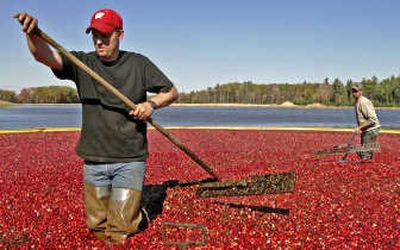Weather, demand put squeeze on cranberries

Thinking of cooking with fresh cranberries this holiday season? You may need a backup recipe.
A combination of poor weather conditions and rising demand for the tart red fruit from health-conscious consumers may lead to shortages by Christmas, industry and retail officials say. Canned sauce, bottled juice and dried cranberry snacks will be available, but prices are expected to rise in coming weeks and months.
As for fresh cranberries, “we won’t have any left for Christmas,” predicts Robert Keane, a spokesman for the Stop & Shop Supermarket Co., a 389-store supermarket chain based in Quincy, Mass., and owned by Royal Ahold in the Netherlands. He calls the projected scarcity “an industry-wide problem.”
Consumers already are seeing slight price increases. The average retail price of a 12-ounce package of fresh cranberries rose eight cents this year to $2.20 from $2.12 in 2006, according to the American Farm Bureau Federation, an organization representing farm and ranch families.
Thanks to new product innovations and efforts to promote the health benefits of the fruit by industry leader Ocean Spray Cranberries Inc. and others, cranberries no longer are relegated to a Thanksgiving side dish. They can now be found in more than 2,000 products from muffin mix to soap. U.S. unit sales of dried cranberries, used to make snacks and as ingredients in other foods, rose nearly 20 percent in 2006, according to Information Resources Inc., a Chicago-based retail-tracking firm.
Cranberries prefer cold winters and plenty of rain. So last year’s unusually warm winter and a summer drought in many parts of the U.S. and Canada hurt the crop now being harvested. Peter Beaton, who grows cranberries in Wareham, Mass., says his overall crop is down about 30 percent this year from a year ago because of the weather.